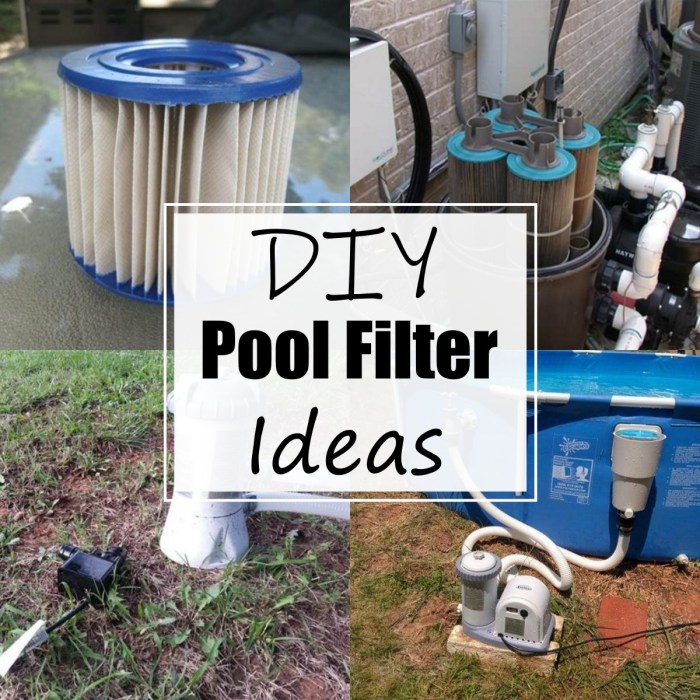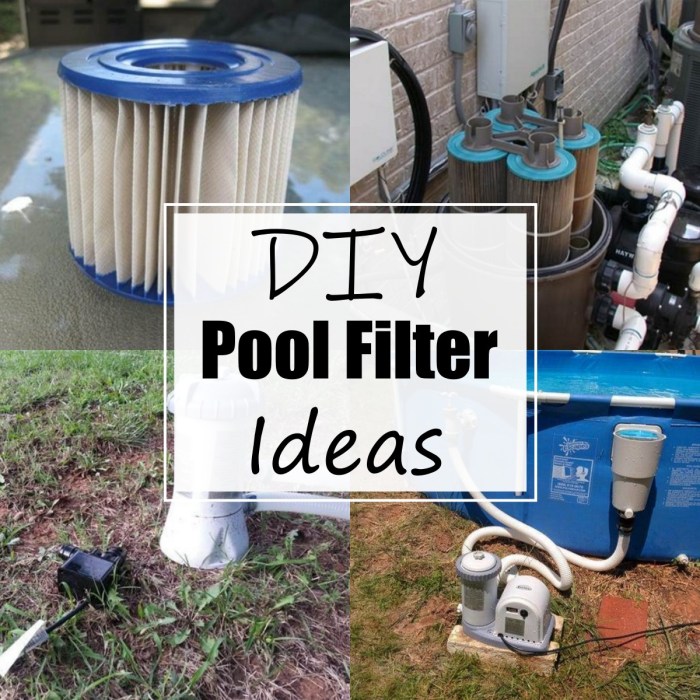DIY pool filter: a phrase that conjures up images of sparkling water and backyard bliss, but also a touch of DIY ingenuity. Building your own pool filter can be a rewarding project, offering a sense of accomplishment and potentially significant cost savings. But before diving into the world of sand filters, cartridge filters, and diatomaceous earth, it’s essential to understand the basics of pool filtration systems and the various types of DIY filters available.
From choosing the right filter type to assembling it, this guide will walk you through the entire process, equipping you with the knowledge and confidence to create a DIY pool filter that meets your specific needs and budget. Whether you’re a seasoned DIY enthusiast or a first-time pool owner, this comprehensive guide will provide the information you need to embark on this exciting project.
Introduction to DIY Pool Filters
Keeping your pool water clean and sparkling requires a reliable filtration system. Pool filters are essential for removing debris, contaminants, and microorganisms, ensuring a healthy and enjoyable swimming experience. While you can purchase pre-made pool filters, building your own DIY filter offers numerous benefits, including cost savings, customization, and a sense of accomplishment.
Benefits of DIY Pool Filters
Building your own pool filter can be a rewarding project, offering several advantages over commercially available options.
- Cost Savings: DIY pool filters can be significantly cheaper than purchasing pre-made filters, especially for larger pools. You can use readily available materials and reduce overall expenses.
- Customization: DIY filters allow you to tailor the design and specifications to your specific pool needs and preferences. You can adjust the filter size, filtration media, and flow rate to optimize performance.
- Learning Experience: Building a DIY pool filter is an excellent opportunity to learn about pool filtration systems and develop practical skills in plumbing, construction, and engineering.
- Sustainability: By using recycled materials or repurposing old equipment, you can create a more environmentally friendly filter system.
Types of DIY Pool Filters
There are various types of DIY pool filters that you can build, each with its own advantages and disadvantages.
- Sand Filters: Sand filters are one of the most common types of DIY filters. They use a bed of sand to trap debris and contaminants. Sand filters are relatively simple to build and maintain, and they are effective at removing larger particles.
- Diatomaceous Earth (DE) Filters: DE filters use a fine powder made from fossilized diatoms to capture even smaller particles. These filters offer superior filtration than sand filters but require more maintenance and can be more expensive to operate.
- Cartridge Filters: Cartridge filters use replaceable filter cartridges that trap debris and contaminants. They are easy to install and maintain but require frequent cartridge replacements, which can be costly over time.
- Drum Filters: Drum filters use a rotating drum covered with filter cloth to capture debris. They are highly efficient and require minimal maintenance but can be more expensive to build and install.
Building a DIY Pool Filter

Building your own pool filter can be a rewarding project, offering cost savings and the satisfaction of a hands-on approach. However, it requires careful planning, attention to detail, and a basic understanding of pool filtration principles.
Sand Filter Construction
Sand filters are a popular choice for DIY pool filtration due to their simplicity and effectiveness. Here’s a step-by-step guide for building a sand filter:
- Choose the Right Size: The filter size should be determined by the volume of your pool. A good rule of thumb is to choose a filter with a flow rate equal to or greater than the pool’s circulation rate.
- Prepare the Filter Tank: A large, cylindrical container made of fiberglass, plastic, or concrete can serve as the filter tank. Clean and prepare the tank, ensuring it is free of debris and any potential leaks.
- Install the Inlet and Outlet Pipes: Connect the inlet and outlet pipes to the tank, ensuring they are securely fastened and properly positioned. The inlet pipe should be at the bottom of the tank, while the outlet pipe should be at the top.
- Add the Sand Bed: The sand bed forms the heart of the filter. Use a high-quality, pool-grade sand with a uniform grain size of 20-40 mesh. Pour the sand into the tank, creating a depth of 18-24 inches.
- Install the Filter Grid: Place a filter grid over the sand bed. This grid prevents the sand from being drawn out of the tank during backwashing.
- Connect the Filter System: Connect the filter to the pool’s plumbing system. This involves connecting the inlet and outlet pipes to the pool pump and return line.
- Backwash the Filter: Once the filter is installed, backwash it to remove any debris and ensure optimal performance. This involves reversing the flow of water through the filter, flushing out the accumulated dirt.
Cartridge Filter Construction
Cartridge filters offer a convenient and efficient alternative to sand filters. Here’s a plan for building a cartridge filter:
- Select a Filter Housing: Choose a filter housing made of durable materials like plastic or fiberglass. The housing should be large enough to accommodate the cartridge and allow for proper water flow.
- Choose the Right Cartridge: Cartridge filters come in various sizes and materials. Select a cartridge that is compatible with the chosen housing and has a flow rate that matches your pool’s circulation rate.
- Prepare the Filter Housing: Clean the filter housing thoroughly, removing any debris or obstructions.
- Install the Cartridge: Carefully insert the cartridge into the filter housing, ensuring it is properly seated and secure.
- Connect the Filter System: Connect the filter housing to the pool’s plumbing system, attaching the inlet and outlet pipes to the pump and return line.
- Replace the Cartridge: Cartridge filters require regular replacement, typically every 3-6 months depending on usage and water quality. Replace the cartridge with a new one once it becomes clogged or dirty.
DE Filter Assembly, Diy pool filter
Diatomaceous earth (DE) filters are known for their exceptional filtration capabilities, removing even the smallest particles from pool water. Here’s a step-by-step guide for assembling a DE filter:
- Prepare the Filter Tank: Clean the filter tank thoroughly, removing any debris and ensuring the tank is free of leaks.
- Install the DE Grids: DE grids are essential for holding the DE powder and providing a filtering surface. Install the grids in the filter tank, following the manufacturer’s instructions.
- Add DE Powder: Pour DE powder into the filter tank, following the recommended dosage for your filter. The DE powder will mix with water and form a thin, porous layer on the grids.
- Prime the Filter: Prime the filter by filling the tank with water and ensuring all air is removed from the system. This allows the DE to properly coat the grids and create a tight seal.
- Connect the Filter System: Connect the filter tank to the pool’s plumbing system, attaching the inlet and outlet pipes to the pump and return line.
- Backwash the Filter: Backwash the filter regularly to remove accumulated debris and maintain optimal performance. Backwashing involves reversing the flow of water through the filter, removing the DE and flushing out the dirt.
Troubleshooting Common Problems

Building a DIY pool filter can be a rewarding project, but like any DIY endeavor, you might encounter some challenges along the way. This section will guide you through troubleshooting common problems you might face with your DIY pool filter.
Low Water Pressure
Low water pressure is a common issue with DIY pool filters, often indicating a blockage or a problem with the pump. Here’s a breakdown of the most common causes and solutions:
- Clogged Filter Media: The filter media, such as sand or diatomaceous earth, can become clogged with debris over time, hindering water flow.
- Air in the System: Air trapped in the filter system can also lead to low water pressure.
- Pump Impeller Problems: A worn-out or damaged pump impeller can reduce the pump’s efficiency and lead to low pressure.
- Clogged Pipes: Sediment or debris buildup in the pipes leading to and from the filter can restrict water flow.
Here are some solutions for low water pressure:
- Backwash or Clean the Filter: Regularly backwashing or cleaning the filter media removes accumulated debris and restores water flow.
- Bleed Air from the System: Bleed air from the filter system by opening bleed valves or air relief valves located on the filter or pump.
- Inspect and Replace the Pump Impeller: If the impeller is worn or damaged, replace it with a new one.
- Clean or Replace Pipes: Clean or replace clogged pipes to restore proper water flow.
Leaks
Leaks are another common issue with DIY pool filters, often occurring at the filter tank connections, pipe joints, or the pump itself.
- Loose Connections: Loose connections at the filter tank, pipes, or pump can lead to leaks.
- Cracked or Damaged Pipes: Cracked or damaged pipes can cause leaks.
- Worn-out Gaskets or O-Rings: Worn-out gaskets or O-rings can allow water to leak past the connections.
- Pump Seal Issues: A worn-out or damaged pump seal can cause leaks from the pump.
Here are some solutions for leaks:
- Tighten Connections: Tighten loose connections at the filter tank, pipes, or pump.
- Repair or Replace Damaged Pipes: Repair or replace cracked or damaged pipes.
- Replace Gaskets or O-Rings: Replace worn-out gaskets or O-rings with new ones.
- Replace the Pump Seal: Replace a worn-out or damaged pump seal with a new one.
Building a DIY pool filter is a journey that combines practical skills with a desire for crystal-clear water. By understanding the different filter types, carefully selecting the right materials, and following the steps Artikeld in this guide, you can create a custom pool filter that enhances your swimming experience and brings you closer to the enjoyment of your own backyard oasis. Remember, safety should always be a top priority, and seeking guidance from experienced pool professionals can be invaluable throughout the process. So, dive in, explore the possibilities, and build a DIY pool filter that reflects your unique style and needs.
Building a DIY pool filter can be a rewarding project, especially if you’re looking to save money and learn some new skills. It’s similar to crafting a photo frame DIY cardboard project in that it involves repurposing materials and getting creative. Just like you need to carefully select and arrange cardboard pieces for your frame, you’ll need to choose the right materials and design for your pool filter to ensure it effectively cleans your water.

